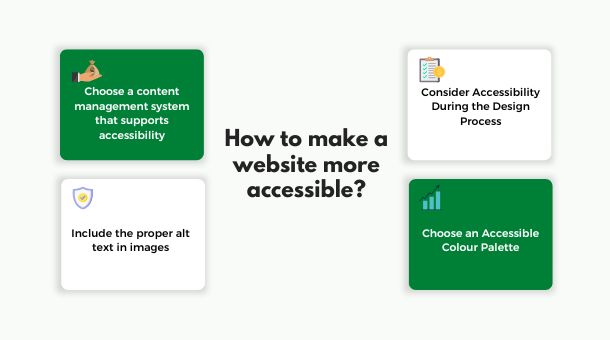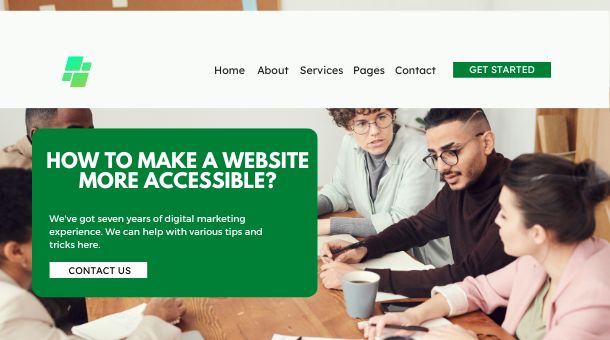In this article, we will discuss ways How to make a website more accessible? Web development is the “one size fits all” issue. Every day, about 500k new websites are made worldwide.
Most websites contain the word “inaccessible”, which prevents the world’s one billion disabled individuals, 15 percent of the world’s population, and 15% of the world’s population from enjoying a smooth internet experience.
Looking into the figures, according to the WHO, 430 million individuals “require rehabilitation to address their ‘disabling’ hearing loss.” It’s also a growing problem, projected to reach 700 million by 2050.
Alongside those with disabilities, There’s also a rising population that we must consider the world’s aging population.
Age-related signs are natural, such as loss of vision, the capacity to handle the cognitive load, and fine motor abilities. These can all be major roles in how older people interact with your site.
What Is Web Accessibility?
Web accessibility is creating and developing tools, websites, and tools that users with disabilities can access as per the World Wide Web Consortium (W3C).
Individuals with disabilities must be able to comprehend, navigate, interact with, and contribute to the internet.
Accessibility to the Web applies to any disability that could impact the ability to access the internet and includes:
- Auditory.
- Cognitive.
- Neurological.
- Physical.
- Speech.
- Visual.
Top 5 ways How to make a website more accessible?

1: Choose a content management system that supports accessibility.
Numerous CMS systems can aid you in building your website. The most popular examples are Drupal and WordPress However, numerous other choices are available.
After selecting the CMS that meets your requirements, select the right theme/template for your needs that is accessible. The theme’s documentation will provide information on accessibility and guidelines for developing accessible layouts and content for this theme. Ensure you follow similar guidelines for choosing modules such as widgets, plugins, or modules.
2: Consider Accessibility During the Design Process
In the initial stages of web design and publishing new content, you should think about various design elements that can improve accessibility.
In addition, they include reading order, a contrast of colours, as well as font size, and easy-to-find hyperlinks. WebAIM.org (Web Accessibility in Mind) has developed a useful, accessible infographic that includes the best design practices.
3: Include the proper alt text in images.
The alt text must be included for images to ensure that screen readers can comprehend the message conveyed through photos on the web page. This is crucial regarding images that provide information (such as infographics).
When you create an alt-text, it must contain the message that you intend to convey via the image. Additionally, if the image contains text, it should be included in the alt.
The only exception to this rule is when images are solely for decoration. in this scenario, the alt text may remain empty(the link can be an external link) so that the screen reader user isn’t distracted by the page’s primary content.
When an image serves as the sole part of the link, the screen reader can read the file’s name even when alt text isn’t included. Always include alt text for images used as hyperlinks.
4: Choose an Accessible Colour Palette
First, you must create an easy-to-use layout for your website. However, a user-friendly layout is not worth the effort if you use incorrect colours. For instance, a smattering of colours makes the text hard to differentiate.
The right colour palette can be a challenge. The majority of 8 percent of men have colour vision impairment (CVD), the most frequent type known as ‘green/red colour blindness.’ It is therefore recommended to avoid these colours whenever possible.
5: Use distinct and meaningful page titles.
A screen reader user will first see the text between your tags immediately after the website completely loads. The most dangerous thing you could do to avoid being able to use tags is not to have tags; are they the same across the entirety of your websites.
This cannot be very clear for those who depend upon the HTML markup to identify which webpage they’re on or whether the page you clicked on is the same page they previously visited.
Is Website Accessibility a Legal Requirement?

Yes.
As per Title III of the Americans with Disabilities Act (ADA), All public spaces must be accessible for people with disabilities. This is true for your site as well. Although the ADA does not specifically mention websites, the US courts apply the term “places of public accommodation” to mean the internet’s public domain.
In denying Domino’s argument, the court emphasized that the ADA’s wording stated that it applied to services provided “of” public accommodation, and that is, not “in” public accommodation. This means that the law applies not only to brick-and-mortar structures but also to other types of public accommodations, too.
In short, for websites to meet ADA-compatible accessibility on the internet is crucial.
If you have accessible sections on your website, the website could be considered discriminatory to people who are disabled and thus violates the ADA. The ADA is an absolute liability law. Infractions due to lack of knowledge or the development of a website in the process of development are not acceptable.
FAQ about How to make a website more accessible?
How are websites made accessible to the disabled?
A website that is accessible does not depend on a mouse; it provides every function accessible via the keyboard. Also, people with disabilities can use assistive technology mimicking the keyboard, like the ability to speak.
How does a blind person access a website?
Assistance technology (AT) is a broad term that refers to the hardware and software that allow disabled people to use technology. For blind people, braille displays and the speech recognition program are the most commonly used AT.
What is accessibility testing?
Testing accessibility is making your website and mobile apps accessible to as many users as feasible. It allows apps to be accessible to people who are disabled, for example, hearing impairment, vision impairment as well as other physical or cognitive impairments.
Are websites subject to ADA?
Section 508 is considered a law that applies to all federal jurisdictions, and the ADA is an act of civil rights. To comply with ADA and 508, it must be accessible for people with disabilities, including users who access the internet using assistive devices.

